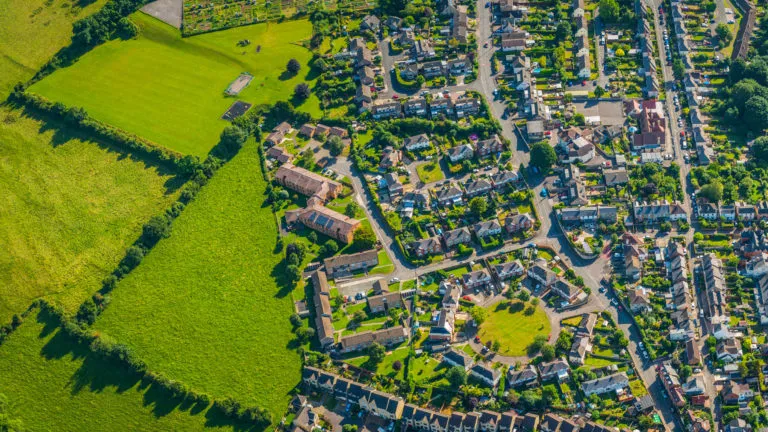Exception sites are a lifeline for communities in need of affordable homes
Published: by Rose Grayston

Here at Shelter, we’re all for getting more affordable homes built. It’s the only long-term, permanent fix to our housing and homelessness crisis. But in recent years, it hasn’t always felt like the planning system is on our side. Rules like the viability loophole have made it harder to get the affordable homes communities really need coming through the planning system. But there is one great, unsung hero of the planning system that has been steadily chipping away at the problem in some parts of the countryside: Rural Exception Sites. Now, the government is expanding this idea through a new Entry Level Exception Sites policy in the draft National Planning Policy Framework (NPPF). With a little fine tuning, this will be a valuable tool in the fight for genuinely affordable homes.
Zoning for genuinely affordable homes
Since 2012, Rural Exception Sites have enabled lower cost affordable housing in pockets of high housing need in the countryside. Small sites which have not been allocated for housing in a Local Plan, and which would not normally be developed, can be used to provide permanent affordable housing to address the needs of local people.
It’s effectively zoning for affordable housing. This sets the price of land for these sites according to the type of housing needed in the community, breaking free from the skewed incentives of the mainstream housebuilding system. Landowners that release exception sites for development don’t get a huge price for their land, but they know that no-one else will make a fortune selling the site on either, and that the homes built will be affordable for local people.
And it works. Since their introduction, Rural Exception Sites have delivered 7,881 affordable homes in villages hit hard by the housing crisis, including 1,875 in Cornwall alone.* Shelter has campaigned for their extension through a system of ‘Neighbourhood Exception Sites’. So we were thrilled to see a similar idea come forward in the new draft NPPF. Entry Level Exception Sites will allow land which has not been allocated for development to be zoned for schemes with ‘a high proportion of entry-level homes that will be offered for discounted sale or for affordable rent’. This could do for urban and suburban communities something similar to what Rural Exception Sites have done for the countryside – with a little fine tuning.
Communities in the driving seat
Key to the success of Rural Exception Sites is their ability to build community confidence and trust by giving a high degree of control to local people. The final NPPF must put communities firmly in the driving seat of Entry Level Exception Sites, too. Decisions about the location, design, tenure, price and allocation of homes must be made with local people. In our view, this should include a right for local communities to proactively choose to build on green belt sites if they have no environmental protection status – a choice which would not be allowed for the government’s proposed Entry Level Exception Sites. Likewise, the decision about whether to build social rent homes which will be affordable in the long-term, Starter Homes which will eventually become market housing, or anything in between, must rest with the community.
Unleashing the potential of exception sites
In the draft wording of the NPPF, Entry Level Exception Sites should have ‘a high proportion’ of affordable homes. A proportion of private housing is allowed, to generate profits which can be used to cross-subsidise the affordable homes – as already happens on many Rural Exception Sites.
This isn’t ideal. We should aim for 100% affordable housing on exception sites wherever possible. But these sites will often be complex and ‘hard to build’ – the nature of the beast when building on land that has not already been earmarked for housing through a Local Plan. Within the confines of the current funding regime for affordable housing, councils will sometimes face a choice between tolerating some private housing on an exception site or losing the scheme altogether.
But to ensure that exception sites serve their purpose, government should use planning rules to set limits to the proportion of market housing which can be included – for example an absolute maximum of 25%. Without this, there’s a risk that exception sites could become another loophole in the planning system, allowing speculative development of unaffordable homes to be imposed on local areas. Crucially, the rules must be standard across both Rural and Entry Level sites, to avoid creating false incentives to prefer one type of site where the other is more appropriate for meeting local needs.
It shouldn’t all be about cross-subsidy, either. Most obviously, government should beef up grant funding for affordable homes on exception sites so that these cover normal build costs. Secondly, as the CLA has pointed out, landowners lack incentives to put their land into the affordable developments communities really need. Government should consider inheritance tax deferment for landowners who gift land for exception sites. These actions would address the two biggest barriers to housing delivery under the exception sites model, unleashing its true potential to deliver more of the affordable homes we need.
Looking ahead
We must be realistic about what exception sites can achieve on their own. By definition they are exceptions, and exist at the margins of a broken housebuilding system which drip feeds expensive, poor quality homes onto the market only as fast as they will sell at inflated prices. Addressing the wider system through stronger planning, more public housebuilding and reforms to lower land prices must remain the priorities. But while their impact on overall supply is limited, exception sites provide a lifeline to communities in desperate need of genuinely affordable homes. The more of them we see in the next few years, the better.
- Read Shelter’s plan to fix the broken housebuilding system in our New Civic Housebuilding report
* MHCLG, Local authority housing statistics data returns, 2011-12 to 2016-17